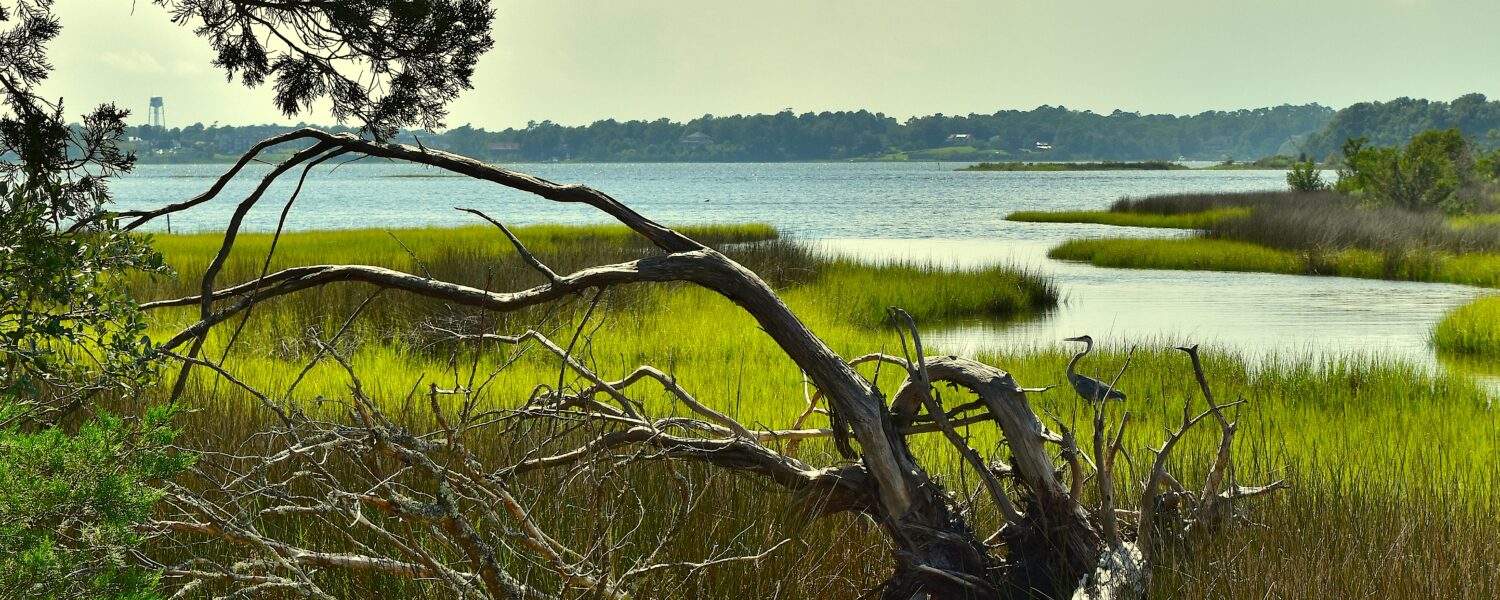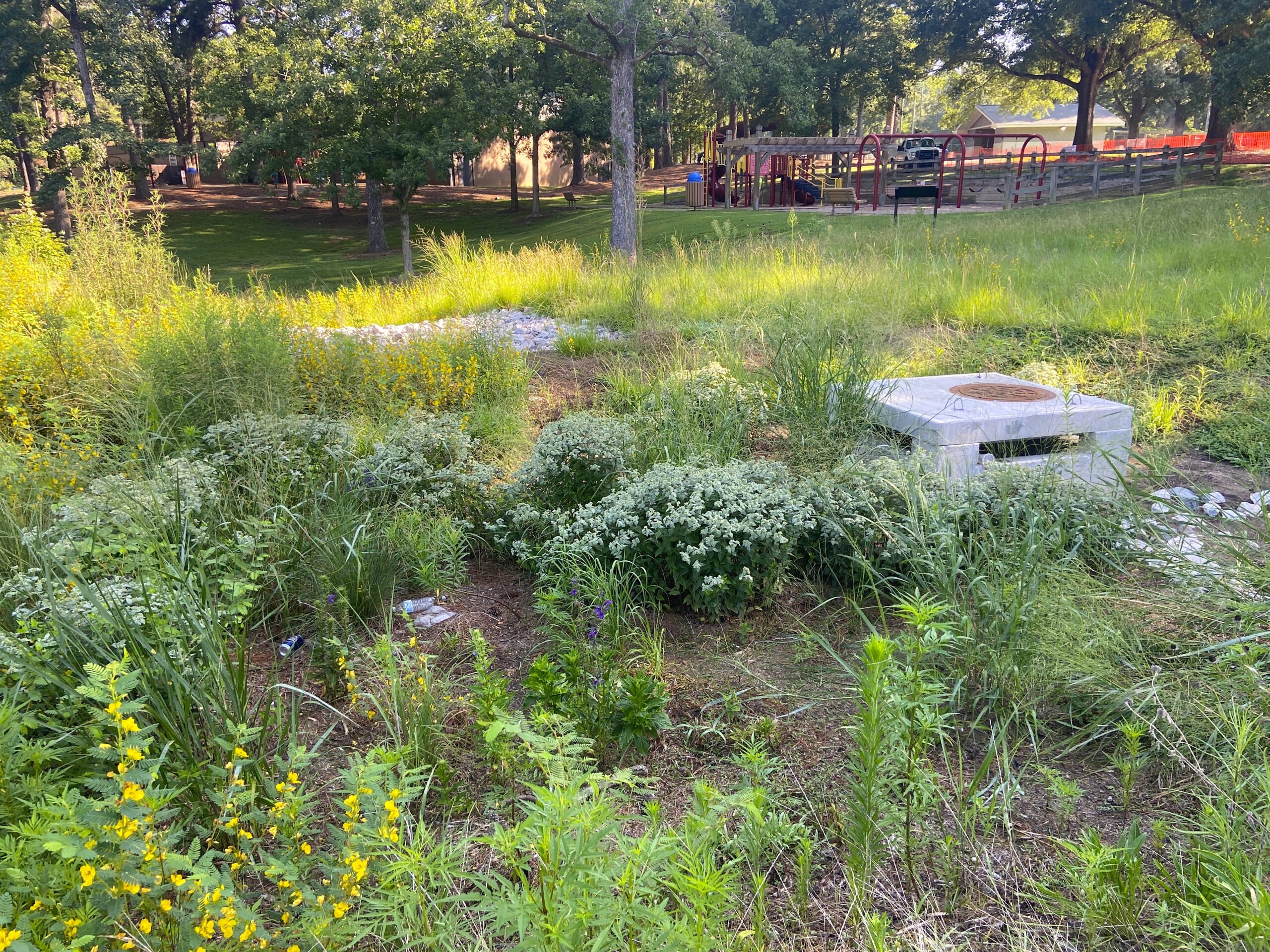From the top of the old firetower overlooking Pocosin Lakes National Wildlife Refuge, the forests appear to stretch to the horizon — with Lake Phelps a far-off line of blue. There are no shopping centers or housing developments in sight. The only sound is the wind sweeping through the tower bars, ruffling the feathers of perching vultures.
It is easy to imagine a time when pocosins dominated the land, and towering Atlantic white cedars supported a thriving ecosystem and growing coastal culture.
Pocosin, a term coined by native Algonquians, describes the bog ecosystems of the southeast. Such ecosystems are known for their unique soil type, vegetative community and fire regime that once, under the right conditions, bred large glades of Atlantic white cedar, Chamaecyparis thyoides. Historically, cedar-dominated pocosin soils were waterlogged and rich in peat — partially decayed plant material accumulated over time.
A mainstay of life on the coast, Atlantic white cedar “traditionally has been the wood of choice preferred by boat builders and decoy carvers,” says Don Pendergraft, exhibits designer with Core Sound Waterfowl Museum on Markers Island.
Also known as juniper, the soft, fragrant wood carves easily, is lightweight and extremely resistant to rot and insect disease, says Pendergraft. Perfect for woodwork, the cedar was valued for its multiple uses, from siding and shingling to channel markers.
Atlantic white cedar became too popular, however. “People liked it so much they just overharvested it,” explains Wendy Stanton, refuge biologist with Pocosin Lakes National Wildlife Refuge. According to Stanton, the pocosin ecosystem has been reduced to less than 5 percent of its original range, and designated “globally threatened” by The Nature Conservancy.
THE CEDAR’S DEMISE
Pocosin Lakes, located in Tyrrell, Hyde and Washington counties, experienced the timber rush in the late 1890s that cleared much of an estimated 200,000 acres of Atlantic white cedar found in eastern North Carolina. Commercial timber companies ditched and drained pocosin wetlands to allow more accessibility for timber harvesting.
“If you look at an aerial photo of the refuge, it’s just a matrix of ditches and canals,” says Stanton as she drives along dirt roads once traveled by logging trucks.
Logging efforts were exhausted by the 1960s. The area then was used for corporate agriculture for several decades.
There was also an attempt to mine peat from the area in the 1980s. However, plans to construct a large peat-to-methanol synthetic fuel plant were abandoned, along with the agricultural enterprise. Thousands of acres were left ditched and drained, exposing eight-foot peat deposits that were 9,000 years old.
By the late 1980s, The Conservation Fund had acquired much of the degraded pocosin habitat, and donated about 93,000 acres to the U.S. Fish and Wildlife Service (USFWS). The donation helped establish Pocosin Lakes National Wildlife Refuge in 1990.
Now, Atlantic white cedar restoration is an ongoing mission for Pocosin Lakes and other refuges in the southeast, where most of the estimated 10,600 remaining acres of Atlantic white cedar are found. Smaller pockets are scattered throughout the cedar’s native range — from Maine to northern Florida and west to southern Mississippi.
REBUILDING THE POCOSIN
When the Pocosin Lakes refuge was first established, officials there partnered with USFWS and North Carolina State University to restore 10,800 acres of pocosin habitat.
The strategy involved returning natural water flow to the pocosin by installing water control structures within the network of canals that would flood the habitat, helping support reforestation efforts of white cedar, bald cypress and other native pocosin vegetation.
Today, about 2,000 acres of pocosin are restored — with 800 acres of white cedar planted and thriving.
“It’s a very high priority to try to restore as much healthy pocosin wetlands as possible to the most natural state as possible,” says Stanton. “The Atlantic white cedar is a large component of that.”
Refuge officials expect to see wildlife associated with the cedar return to the restored area, including nesting songbirds and declining species, such as the black-throated green warbler, woodcock, black bear and eastern diamondback rattlesnake.
WATER QUALITY BENEFIT
Pocosins, specifically Atlantic white cedar bogs, naturally hold and filter runoff before it enters surrounding waterways, improving water quality downstream. Water from a pocosin wetland is often cleaner than rainwater.
However, when the refuge’s peat lands were ditched and drained for logging and peat mining, they became aerated, causing an increase in microbial activity that accelerates decomposition and nutrient release.
As a result, runoff from Pocosin Lakes exceeded North Carolina water quality standards for mercury. Excess nitrogen also contributed to excessive plant and algal growth in downstream areas of the Albemarle-Pamlico Sound. Known as eutrophication, this process reduces dissolved oxygen content in the water, and can harm fish and other animals.
“We would like to see the whole site become nonpolluting and actually beneficial to the sound,” says Mike Wicker, Albemarle/Pamlico coastal ecosystems coordinator for USFWS.
Mercury runoff has been the easiest to reduce, Wicker notes. After restoring just one 640-acre plot, previously toxic mercury levels quickly became better than the state standard. “The restored sections of that site now are just as clean as rainwater,” he adds.
Reductions in nitrogen also have occurred, but reaching the ultimate goal — site runoff with mercury and nitrogen levels equal to, or less than, that found in rainfall — will take an estimated 10 to 15 years. For the pocosins to achieve their full clean-up potential, the remaining 10,800 acres must be restored, says Wicker.
However, funding is scarce. “It would be a real bargain to restore the remaining acreage,” Wicker says.
Education would help the project move forward, he suggests, adding that the public is not familiar with deep peat wetlands in North Carolina.
“If they were more aware, they’d be begging us to restore it,” Wicker says.
STRUGGLING TO TAKE ROOT
The project is a long-term effort with many challenges — including awareness, funding and restoration. But some point to the high population of deer on the refuge as the biggest problem — a deer can chew a 4-foot-tall seedling down to just inches.
“They make it like a little bonsai tree,” says Bill Pickens, silviculturalist with the N.C. Division of Forest Resources (DFR). “There are way too many deer in eastern North Carolina where white cedar is found.”
In efforts to find ways to protect seedlings from animal damage, Eric Hinesley of NC State’s horticultural department has worked with USFWS at the refuge and the DFR. They have tested tree shelters, wire cages, electric fences and other devices, but the overall costs exceeded the benefit for large-scale plantings. The best defense for the refuge, according to Stanton, may be the recent introduction of the red wolf back to the area — the only natural predator left to control deer.
Restoration also has been thwarted by a scarcity of cedar plants.
Two years ago, DFR was producing about 20,000 plants per year — barely enough to support restoration in Pocosin Lakes. Current demand is much greater.
“There’s been a lot of interest in restoring white cedar,” says Hinesley. “Longleaf pine is an excellent example of a tree that has come back because of efforts to restore it and replant it, and I think the exact same thing can be done with white cedar.”
By experimenting with Atlantic white cedar plants in a nursery setting, DFR, in collaboration with Hinesley, now provides several hundred thousand good quality, containerized seedlings to university, industry, private and government personnel for planting and regeneration each year.
“We’ve been working hard to find the best way to grow containerized white cedar, and I think there will be a lot more plants available in the future,” Hinesley says.
JUNIPER OF THE MILLENNIUM
In the late 1990s, Feather Phillips, executive director of Pocosin Arts Folk School and Gallery, envisioned “a project of millennial proportions” that would suit small Tyrrell County and places like it on the North Carolina coast.
Touted as “unspoiled, uncrowded, uncomplicated,” Tyrrell is the least populated county in the state, according to the 2000 census. The county is home to three protected areas — Pocosin Lakes National Wildlife Refuge, the Emily and Richardson Preyer Buckridge Coastal Reserve, and the new Palmetto-Peartree Preserve. Each is devoted to environmental conservation and preservation of coastal heritage.
In concert with the mission of Pocosin Arts — a traditional arts education center located in Columbia and dedicated to “connecting culture to environment through the arts” — Tyrrell residents gathered with friends and partners to plant a “Millennium Forest” of 7,000 young juniper trees.
The project — 7000 Juniper: An Art Action for the Millennium — was inspired by Joseph Beuys, a German artist famous for planting 7,000 oak trees in Kassel, Germany, in 1982. The 7000 Oaks project symbolized a movement to reforest the country and left a legacy that continues to spread across the world — with plantings in the British Isles, France, Holland, Italy and the United States.
On March 20, 2000, the dawn of the vernal equinox, Phillips initiated the first of four plantings for the millennium forest, creating a place where both residents and visitors of the pocosin region could find solace under a quiet cathedral of jumper trees.
Handmade clay markers were buried with each new juniper, expected to last 1,000 years as a memorial of the day, of the care taken by the project and people involved, and of loved ones celebrating in spirit.
“Combining ritual with the planting and initiating of the forest was part of the imprinting in the minds of the children that this was special, this was powerful, this was worth our care,” says Phillips.
The last juniper in the millennium forest was planted on April 7, 2004, in Pocosin Lakes. A public celebration marked the event, complete with the release of a young bald eagle by the Carolina Raptor Society in honor of life and an effort to give back to nature.
Watching the eagle circle overhead and take flight was a pinnacle moment for Phillips and others present. But the vision is not yet complete — the trees are still growing. Some have reached 12-feet-tall, others only 12 inches.
“It’s a work of art that you can have in your imagination…A Stonehenge idea…A
place of ritual,” Phillips explains. “I’m still imagining, and it looks like it’s going to be great.”
The millennium project is now a budding seven-acre forest. Shedding the exactitude offered by tape measures and technological gadgets, Carl Twarog and Eva Roberts, faculty members at East Carolina University’s School of Art, designed the plantings in concentric circles to emphasize the human dimensions of this visionary forest.
To form the circles, the volunteers — including more than 500 students — held hands, and the seedlings were planted at their feet. Two giant steps measure the distance between each circle in the imperfect, yet successful, pattern.
“The idea of a perfect anything was thrown out the window,” says Phillips of the unusual planting method. “We really wanted to pay honor and tribute to the way trees really grow.”
In 100 years or so, when the junipers are overhead, the small center circle will remain — tended as the tree cathedral Phillips first envisioned — a sacred place.
This article was published in the Early Summer 2005 issue of Coastwatch.
For contact information and reprint requests, visit ncseagrant.ncsu.edu/coastwatch/contact/.
- Categories:



